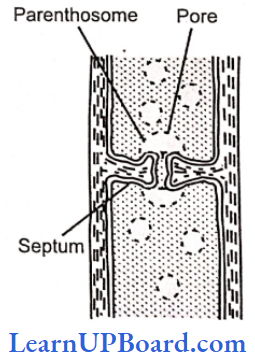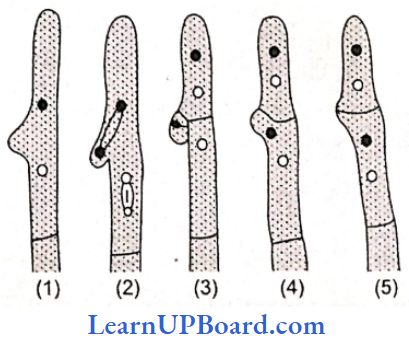NEET Biology Notes PDF Free Download
NEET Biology Notes For Penicillium
- Facultative parasite and saprophytic fungi.
- Mycelium is branched septate with simple septal pores and each cell is uni or multinucleate depending upon the species.
- Asexual Reproduction: By conidia. Conidiophores are often branched. The ultimate branches or metulae of conidiophore possess bottle-shaped sterigmata. Each sterigmata produces a chain of conidia. The conidia in the chain are arranged in basipetal order. Each conidium is uninucleate, non-motile, two-layered, dispersed by air, and germinates to form new mycelium.
- Sexual Reproduction: It produces dikaryophase and ascocarp. The ascocarp is a cleistothecium type. Each ascus has eight ascospores. Ascospore germinates to form new mycelium.
Read and Learn More NEET Biology Notes
NEET Biology Notes For Importance Of Penicillium
- Penicillin (the wonder drug, the first antibiotic): Flemming discovered penicillin from Penicillium notation. Nowadays, it is obtained commercially from P. chrysogenum.
- Griseofulvin and brefeldin are obtained from P. griseofulvin and P. brefeldin, respectively.
- Ripening of Camembert and Roquefort types of cheese is carried out by P. camemberti and P. roqueforti, respectively.
Some More Ascomycetes And Their Importance
- Aspergillus flavus: It produces a carcinogenic toxic called aflatoxin.
- A. oryzae: Source of diastase enzyme
- Claviceps Purpurea: Ergot of rye disease. Source of LSD (lysergic acid diethylamide)
- Erysiplte Graminicola: Powdery mildew of cereals.
- Morchella (morel): Ascocarp is edible, for example, Morchella esculent.
- Tuber (truffle): Ascocarp is edible, for example, Tuber aestivum.
NEET Biology Notes For Basidiomycetes (Club Fungi)
- They are decomposers of wood. They decompose cellulose and lignin. These are the most commonly seen fungi.
- Primary mycelium is monokaryotic (n) and short-lived. Secondary mycelium is bikaryotic (n + n) and long-lived.
- Septa bear dolipore except for rusts and smuts.

Clamp connections are present. They are meant for proper distribution of dikaryon at the time of cell division.

Basidiospores are four in number and are produced exogenously at the tip of sterigmata. In Agaricus bisporus, only two basidiospores are formed from each basidium.
NEET Biology Notes For Life Cycle Of Mushroom
- Agaricus (Psqffiota) campestris is the common field mushroom that has edible basidiocarp. The fungus is saprotrophic.
- The vegetative or assimilative part of mycelium is subterranean. It is found in moist humus-rich soil of open fields, grasslands, and piles of straw. The mycelium multiplies by fragmentation. Occasionally, oidia and chlamydospores are also formed.
- Mushrooms contain two types of mycelia, primary and secondary. Primary mycelium is short-lived. It consists of septate hyphae having monokaryotic cells or cells with a single nucleus. Sex organs do not differentiate.
- The mycelia are heterothallic, that is, there are two mating types, (+) and H. The hyphae of two matting types come in contact and show somatogamy or fusion between their cells. However, only plasmogamy occurs at this time. It gives rise to a dikaryotic cell that grows, divides, and produces a long-lived and extensive dikary¬otic or secondary mycelium.
- The hyphae of secondary mycelium show clamp connections and dolipore septa. Its cells possess two haploid nuclei (n + n) instead of the single diploid nucleus (2n) in diplophase or a single haploid nucleus (n) in haplophase.
- Under favorable conditions, hyphae of secondary mycelium collect at places and give rise to rounded or pyriform compact masses of hyphae called buttons. The buttons enlarge and produce aerial basidiocarps.

The basidiocarps of Agaricus are cream-colored to pinkish brown. In contrast, the secondary mycelium, from which mushrooms develop, is known as spawn. The basidiocarps or mushrooms often lie in rings. The latter are spoken as fairy rings.
- Each basidiocarp or mushroom consists of two parts, stipe and pileus. The stipe or stalk is fleshy. It is slightly swollen at the base. The pileus is an umbrella-like cap of the mushroom. In the button stage, the pileus is connected to the stipe, by a membrane called a veil or velum. It ruptures during the growth of pileus.
- However, its remains can be seen on the upper part of the stipe as the annulus. The pileus is circular in outline. The upper surface is more or less convex. The undersurface is flat or concave. It bears 300-600 radiating rows of vertical plates named gills (lamellae).
- The two sides of the vertically placed basidiocarp are lined by thousands of club-shaped basidia along with sterile paraphyses (singular paraphysis). The two together constitute the fertile layer or hymenium of the gill.

Hymenium is subtended by compact subhymenium. The center consists of interwoven hyphae. It is called trauma. Each basidium functions as the site for both karyogamy and meiosis.
- The two nuclei fuse to form a short-lived diploid synkaryon. The latter then divides meiotically giving rise to four haploid nuclei, two of (+) strain and two of (-) strain.
- The free end of the basidium now develops four peg-like outgrowths called sterigmata. Each sterigma forms an ovoid pinkish-purple meiospore at its tip, the same is termed as basidiospore
- A droplet is collected at the base of each basidiospore which creates tension for breaking and throwing the same. The air current carries away the discharged basidiospores. Basidiospores are of two strains, (+) and (-). After falling on a suitable substratum, each basidiospore germinates to produce monokaryotic primary mycelium.
- The fruiting bodies (basidiocarps) of Agaricus arise in concentric rings (called fairy rings/final flowers) from the mycelium present in the soil. Since the ring of underground mycelium spreads centrifugally, the diameter of the fairy ring also increases every year.
